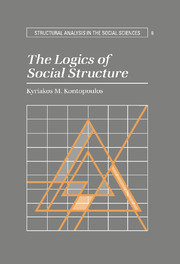Book contents
- Frontmatter
- Contents
- Preface
- Introduction
- Part I Metatheoretical considerations
- 1 Epistemic strategies in contemporary science
- 2 The dynamics of emergence: the case against reductionism
- 3 The nature of hierarchical and heterarchical organization
- 4 Some formal theses on hierarchy and heterarchy
- Part II Compositionist logics
- Part III Logics of hierarchy
- Part IV Heteracrchical logics
- Part V The phenomenology of social structures
- Appendix: The logics of structuration
- Glossary
- Bibliography
- Index
3 - The nature of hierarchical and heterarchical organization
Published online by Cambridge University Press: 24 October 2009
- Frontmatter
- Contents
- Preface
- Introduction
- Part I Metatheoretical considerations
- 1 Epistemic strategies in contemporary science
- 2 The dynamics of emergence: the case against reductionism
- 3 The nature of hierarchical and heterarchical organization
- 4 Some formal theses on hierarchy and heterarchy
- Part II Compositionist logics
- Part III Logics of hierarchy
- Part IV Heteracrchical logics
- Part V The phenomenology of social structures
- Appendix: The logics of structuration
- Glossary
- Bibliography
- Index
Summary
The acceptance of emergence, under any of its weaker, moderate, or stronger conceptualizations, but especially in the case of the latter two, automatically commits one to the view that the world is differentiated not only horizontally in terms of phenotypes but vertically, in terms of different levels; that is, that it exhibits an integrated pluralistic structure (Bhaskar 1975; Bunge 1969, 1973a and b; Popper 1982). This view has been commonsensically expressed by authors writing in several fields: the phenomena of the world, they argue, cannot be either so randomly racemic or so globally interconnected as not to exhibit some differentiation from each other. Minsky, for instance, writing about the possibility of extraterrestrial communication, begins with the following argument: “There can't be any objects, things, or causes in worlds where everything that happens depends, more or less equally, on everything else that happens… To deal with something complicated, you must find a way to describe it in terms of substructures within which the effects of actions tend to be localized. To know the cause of a phenomenon is to know, at least in principle, what can change or control it without changing everything else” (1985: 136). In a similar vein, our premiere social methodologist, Blalock, has asserted that “[T]he theorist must make the fundamental assumption that the real world can be approximated by a block-recursive model, in which the total set of variables can be partitioned into blocks in such a way that there is no feedback between blocks” (1969).
- Type
- Chapter
- Information
- The Logics of Social Structure , pp. 42 - 58Publisher: Cambridge University PressPrint publication year: 1993



